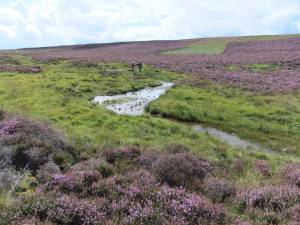|
| *****SWAAG_ID***** | 834 |
| Date Entered | 25/08/2014 |
| Updated on | 25/08/2014 |
| Recorded by | Tim Laurie |
| Category | Fauna |
| Record Type | Fauna HER |
| SWAAG Site Name | |
| Site Type | |
| Site Name | |
| Site Description | |
| Site Access | Public Access Land |
| Location | Crosby Ravensworth Moor. Black Dub. |
| Civil Parish | Not known |
| Brit. National Grid | Hidden |
| Altitude | 320m |
| Geology | Tufa forming spring stream rising from fissured limestone. |
| Record Name | Smooth newt at Black Dub, the source of The River Lyvennet |
| Record Description | This image shows a very pale, straw coloured, Common or Smooth Newt (Triturus vulgaris) at rest on algae in the stream which meanders through the Black Bog on Crosby Ravensworth Moor. When first seen, I thought that this pale ghost of a creature was a troglodyte emerging into daylight from the limestone fissure from which the small stream emerges as the Source of the River Lyvennet. However, I now understand that this pale colour is within the usual range of colouration of this species. |
| Dimensions | See photos. |
| Geographical area | |
| Species | |
| Scientific Name | |
| Common / Notable Species | |
| Tree and / or Stem Girth | |
| Tree: Position / Form / Status | |
| Tree Site ID | 0 |
| Associated Site SWAAG ID | 0 |
| Additional Notes | Reference: T.T. Macan and E.B. Worthington. 1951. 'Life in Lakes and Rivers'. The New Naturalist Series. Collins.
Three species of newts are native and widespread across Britain, the Great Crested Newt is most abundant in Southern England, the Palmate Newt at higher latitudes and also at higher altitudes. The Common or Smooth Newt (T. vulgaris) is not the most common of the three in many areas. During April, these creatures seek ponds or low energy streams and are aquatic for a few weeks and live an existence quite different from their terrestrial way of life. |
| Image 1 ID | 5801 Click image to enlarge |
| Image 1 Description | Troglodite perhaps. Smooth newt at rest on algae colony in the stream meandering through Black Dub at the Source of the River Lyvennet. |  |
| Image 2 ID | 5802 Click image to enlarge |
| Image 2 Description | Black Dub, view upstream. |  |
| Image 3 ID | 5803 Click image to enlarge |
| Image 3 Description | The spring source of the River Lyvennet. |  |


